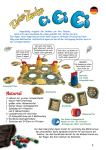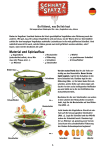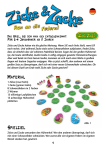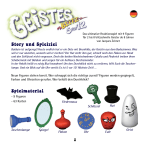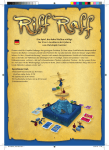Download Zoch Mucca Pazza
Transcript
Für 2 bis 4 findige Kinder ab 4 Jahren von Iris Rossbach Material und Spielaufbau 1 Spielplan 30 Schiebeplättchen (je 10x Kopf, Körper, Beine) 12 Holzsterne 30 Tierkärtchen und 1 Geisterkärtchen Die Kuhpiteraner sind gelandet! Aber die freche Kuh Mucca Pazza hat mal wieder Schabernack mit ihren Freunden getrieben. Beim Teleportieren von ihrem Heimatplaneten Kuhpiter zur Erde hat sie auf den verbotenen „Salto Mortale“-Knopf gedrückt. Und plötzlich sind Kopf, Körper und Beine von allen Tieren wild durcheinander gemischt. Jetzt laufen plötzlich Frodraffen, Kakadroschen und Hutzehörner umher und suchen ihre Köpfe und Bäuche. Könnt ihr ihnen helfen die richtigen Körperteile wieder zu bekommen? Mucca Pazza könnt ihr ab 4 Jahren spielen. Dazu benutzt ihr 5 Tiere, den Geist und nur den halben Spielplan. Wenn ihr das gut könnt oder schon älter seid, warten größere Herausforderungen auf euch: Mucca Pazza ab 6 Jahren spielt ihr mit allen Tieren, dem ganzen Spielplan, den Holzsternen und etwas anderen Spielregeln. Beide Spielvarianten haben ihren ganz eigenen Reiz. Probiert es aus! SPIELZIEL Im Spiel verstecken sich diese 10 Tiere (im Spiel ab 4 Jahren sind es 5 Tiere). Jedes besteht aus Kopf, Körper und Beinen. Zu Spielbeginn sind die Körperteile der Tiere bunt durcheinander gemischt. Eure Aufgabe ist es, die Tiere wieder richtig zusammenzuschieben. Vor dem ersten Spiel löst ihr alle Teile vorsichtig aus den Stanztafeln. Für das Spiel ab 4 Jahren setzt ihr 4 Stege in die gestanzten Löcher einer Spielplanhälfte. Für das Spiel ab 6 Jahren steckt ihr 8 Stege in die Löcher des komplett aufgeklappten Spielplans. Lasst die Stege auch dann im Spielplan stecken, wenn ihr das Spiel wieder zurück in die Schachtel räumt! Die übrigen Stege sind Ersatz. Mucca Pazza ab 4 Jahren Decke ein Tier auf und versuche es dann zusammenzuschieben. SPIELVORBEREITUNG - Legt den Spielplan zusammengefaltet mit den Stegen nach oben in die Tischmitte. - Entscheidet euch für 5 Tiere, mit denen ihr spielen wollt. Im Spiel ab 4 Jahre spielt Ihr nur mit 5 Tieren. - Sucht alle Schiebeplättchen dieser Tiere heraus (Kopf, Körper und Beine). Die restlichen Tiere und die 12 Holzsterne benötigt ihr nicht und lasst sie in der Schachtel. - Legt die 5 Tierköpfe dieser Tiere in die oberste Reihe nebeneinander. - Körper und Beine dieser Tiere legt ihr so darunter, dass wilde Promenadenmischungen entstehen, die immer von 3 verschiedenen Tierarten stammen. - Nun sucht ihr euch noch die 15 Tierkärtchen heraus, die diese 5 Tiere zeigen (3 Kärtchen je Tier). Mischt das Geisterkärtchen mit diesen Tierkärtchen und legt alle verdeckt neben dem Spielplan aus. Die anderen Tierkärtchen werden nicht benötigt und bleiben in der Schachtel. Jetzt kann’s losgehen! Der jüngste Spieler beginnt. Tierkärtchen SPIELABLAUF Kannst du dieses Tier richtig zusammenschieben? Ihr spielt im Uhrzeigersinn. Wenn du am Zug bist, deckst du ein Tierkärtchen auf. Jetzt versuchst du die Plättchen auf dem Spielplan so zu schieben, dass Kopf, Körper und Beine dieses Tieres zusammenpassen. Dabei musst du folgende Regeln beachten: Schieberegeln: - Du schiebst immer mit dem äußersten Plättchen einer beliebigen Reihe alle übrigen Plättchen dieser Reihe um genau einen Platz weiter. - Das Plättchen, das am Ende der Reihe herausfällt, setzt du am anderen Ende wieder ein. 11 3 2 - Du darfst von links nach rechts oder von rechts nach links schieben. - Du darfst jedes Mal eine andere Reihe oder auch mehrmals die gleiche Reihe schieben. - Du darfst maximal dreimal schieben. Ist das Tier nach maximal dreimal Schieben vollständig zu sehen, legst du das Tierkärtchen als Belohnung vor dir ab. Gelingt es dir bereits mit ein- oder zweimal Schieben, endet dein Zug ebenfalls erfolgreich. Jetzt ist der nächste Spieler am Zug. Ist nach dreimal Schieben das Tier nicht „komplett“, deckst du das Tierkärtchen wieder zu und dein linker Mitspieler ist am Zug. Er darf das gleiche Kärtchen aufdecken. Gleiches Tier Deckst du ein Tier auf, das auf dem Spielplan jetzt gerade vollständig zu sehen ist, drehst du das Tierkärtchen wieder um und deckst sofort ein anderes auf (so lange bis ein Tier erscheint, das nicht komplett zu sehen ist). Geisterkärtchen Deckst du das Geisterkärtchen auf, versuchst du ein beliebiges Tier zusammenzuschieben, das auf dem Spielplan momentan nicht komplett zusammengesetzt ist. Gelingt es dir, legst du das Geisterkärtchen vor dir ab. Spielende und Gewinner Habt ihr das letzte Tierkärtchen verteilt, endet das Spiel. Sollte das letzte Tierkärtchen ein Tier zeigen, das auf dem Spielplan komplett zu sehen ist, bekommt es der Spieler, der es aufgedeckt hat einfach so. Gewinner ist, wer jetzt die meisten Tierkärtchen gesammelt hat. Natürlich zählt ihr auch das Geisterkärtchen dazu. Es kann mehrere Gewinner geben. Mucca Pazza ab 6 Jahren Versuche, durch Schieben der Plättchen, ausliegende Tiere zusammenzuschieben. SPIELVORBEREITUNG - Ihr spielt mit dem kompletten, aufgeklappten Spielplan und mit allen Tieren. - Das Geisterkärtchen spielt nicht mit. - Legt alle Tierköpfe in die oberste Reihe. Körper und Beine dieser Tiere legt ihr so darunter, dass wilde Promenadenmischungen entstehen. Es darf kein Körperteil in der mittleren Reihe zum Kopf darüber und zu den Beinen darunter passen. - Aus den 30 gemischten Tierkärtchen deckt ihr 10 Stück auf und legt sie auf den Landeplatz über der obersten Plättchenreihe. Gleiche Tiere werden leicht versetzt übereinander, verschiedene Tiere nebeneinander ausgelegt (siehe Bild unten). Die restlichen Tierkärtchen werden als verdeckter Stapel über dem Landeplatz abgelegt. - Jeder von euch nimmt sich außerdem 3 Holzsterne. Der jüngste Spieler beginnt. Landeplatz Spielablauf Ihr spielt im Uhrzeigersinn. Wenn du am Zug bist, versuchst du eines der Tiere, das du auf dem Landeplatz siehst, auf dem Spielplan zusammenzuschieben, so dass Kopf, Körper und Beine des Tieres zusammenpassen. Du beachtest dabei die Schieberegeln von Seite 3. Holzsterne Die Holzsterne erlauben dir mehr als dreimal zu schieben. Für jeden Holzstern, den du während deines Zuges abgibst, darfst du einmal zusätzlich schieben. Jeder Spieler darf in einer Partie also bis zu dreimal zusätzlich schieben, wenn er will. Abgegebene Holzsterne kommen in die Schachtel. Komplette Tiere Sind ein oder sogar mehrere Tiere nach dem Schieben vollständig zu sehen, legst du alle auf dem Landeplatz ausliegenden Tierkärtchen dieser Tiere als Belohnung vor dir ab. Die gleiche Menge an Tierkärtchen, die du vom Landeplatz genommen hast, legst du sofort vom verdeckten Stapel wieder nach. Sind nicht mehr genug Kärtchen im Stapel, legst du die restlichen Tierkärtchen auf den Landeplatz. Jetzt ist der nächste Spieler am Zug. Kein komplettes Tier Ist nach dem Schieben kein Tier komplett zu sehen, bekommst du kein Kärtchen und der nächste Spieler ist am Zug. Das gilt auch für den Fall, dass du ein Tier zusammenschiebst, von dem kein Kärtchen auf dem Landeplatz ausliegt. Spielende und Gewinner Sobald das letzte Tierkärtchen vom Stapel aufgedeckt wurde, ist jeder von euch noch einmal am Zug, dann endet das Spiel. Gewinner ist, wer jetzt die meisten Tierkärtchen gesammelt hat. Bei Gleichstand gewinnt, wer noch die meisten Holzsterne besitzt. Es kann mehrere Gewinner geben. Autorin: Iris Rossbach Illustration: Iris Rossbach Art.Nr.: 60 110 5044 Vertrieb in der Schweiz: Carletto AG Moosacherstraße 14, Postfach CH-8820 Wädenswil www.carletto.ch 5 © 2013 Zoch GmbH Brienner Str. 54a 80333 München www.zoch-verlag.com www.facebook.com / zochspiele www.twitter.com / Zoch_Spiele For 2 to 4 clever children 4 years and up of Iris Rossbach Materials and Game Set-up 1 gameboard 30 sliding tiles (10 each of head, body and legs) 12 wooden stars 30 animal cards and 1 ghost card The Cowpiterrans have landed! But Mucca Pazza, the silly cow, has been playing tricks on her friends again. While teleporting from their home planet Cowpiter, she pressed the wrong button – and suddenly the heads, bodies and legs of all animals got wildly mixed up. Now all of them constantly give one another new names. The frog head with the dragon belly and monkey legs is called frodrankey. Next to him is a cockapirtle, a cockatoo with a pig head and turtle legs. And what do you think is a houndzebhorn? You will certainly soon see for yourself. Can you help them get their own body parts back? Mucca Pazza can be played from 4 years on. For this, you use 5 animals and only half the gameboard. If you manage it well or are older than 4, bigger challenges await you: Mucca Pazza from 6 years on is played with all animals, the wooden stars, the entire gameboard, and slightly different game rules. Both game variants have their own appeal. Try them out! Object of the Game These 10 animals are hiding in this game. Each of them consists of a head, body and legs. At the beginning of the game, the animals‘ body parts are completely mixed up. Your job is to slide the animals back together correctly. Before you play for the first time, carefully punch out all the pieces from the die-cut sheets. For the game from 4 years on, you insert 4 strips in the punched-out holes of half the gameboard. For the game from 6 years on, you stick 8 strips into the holes of the completely unfolded gameboard. Keep the strips in the gameboard when you put the game back in the box! The remaining strips are spare parts Mucca Pazza from 4 Years on Flip over one animal card and then try to slide together the animal depicted, using the appropriate tiles. Set-up - Put the folded-together gameboard in the middle of the table with the strips upward. - Choose 5 animals with which to play. In the game from 4 years on, you play only with 5 animals. - Pick out all the sliding tiles of these animals (head, body and legs). The other 5 animals and the 12 wooden stars are not needed; put them back into the box. - Place the 5 heads of these animals next to one another in the top row. - Put the bodies and legs of these animals below them in such a way that wild crossbreeds come into being. The three tiles forming such a crossbreed always need to be from three different kinds of animals. - Now select the 15 animal cards that show these 5 animals (3 cards per animal). Shuffle the ghost card into these animal cards and put them all face down on display next to the gameboard. The other animal cards are not used. Now you can begin! The youngest player starts. animal cards Course of the Game Can you slide together this animal correctly? Play proceeds clockwise. On your turn, you flip over an animal card. Slide the tiles so that the matching head, body and legs of the animal fit together. Sliding rules: - You may „slide“ up to three times. - Sliding means: You always slide the outermost tile of any row. You use this tile to slide all the other tiles in this row exactly one place ahead. - The tile that falls off the end of the row is placed at the other end of the row. 11 8 2 - You may slide from left to right or from right to left. - You may slide a different row each time or the same row several times. - Once an animal has been slid together completely, your turn successfully ends. If, after a maximum of three slides, the animal is completely showing, you get the animal card as a reward and put it down in front of you. Now it‘s the next player‘s turn. If the animal is not „complete“ after three slides, you turn over the animal card again in the same place. Now it‘s your left neighbor‘s turn. He is allowed to reveal the same card. The same animal If you reveal an animal that is already showing as a complete animal on the gameboard, you turn the animal card back over again. Then you immediately reveal another card (until a different animal comes up). Ghost card If you reveal the ghost card, you may slide together any animal that has not yet been completely put together on the gameboard. If you succeed, you put the ghost card down in front of you. Ending and Winning the Game When you have distributed the last card, the game ends. In case the final animal card shows an animal that is already complete on the gameboard, the lucky guy who has revealed this card just takes it. This ends the game. The player who has collected the most animal cards is the winner. Of course, the ghost card is counted, too. There can be more than one winner. Mucca Pazza from 6 Years on By sliding the tiles, try to slide together laid-out animals. Set-up - You play with the complete unfolded gameboard and with all animals. - Place all animal heads in the top row. Lay the bodies and legs of these animals below so that wild crossbreeds are created. No body part in the middle row may fit with the head above or the legs below. - The ghost card is not used. - Shuffle the 30 animal cards and form a face-down pile. Flip over 10 cards and place them on the landing place above the top row of tiles. Animals of the same kind are laid out partly overlapping; different animals are laid out next to one another. - In addition, each of you takes 3 wooden stars. landing place Course of the Game Play proceeds clockwise. On your turn, you try to slide one of the animals visible on the landing place together on the gameboard, so that the head, body and legs of this animal fit together. With this, the sliding rules from page 8 apply. If, after the sliding, one or more animals are completely showing, you get all displayed animal cards of these animals as a reward and put them down in front of you. Now it‘s the next player‘s turn. Wooden stars The wooden stars allow you to slide more than three times. For each wooden star that you give up during your turn, you may slide one additional time. So, in one game, each player may additionally slide up to three times if he wishes. The wooden stars you have used up are put back into the box. If there is no completed animal showing after the sliding, you don‘t get any card and it becomes the next player‘s turn. This applies also in the case where you slide together an animal for which no card is lying out on the landing place. Replenishing the landing place After taking animal cards from the landing place, you immediately put the same amount of cards back there from the face-down pile. If there are not enough cads left in the pile, you lay out whatever is remaining. Ending and Winning the Game As soon as the final animal card from the pile has been revealed, each player has one turn left; then the game ends. The player who has collected the most animal cards is the winner. In case of a tie, the player with the most wooden stars left wins. There can more than one winner. Designer: Iris Rossbach Artist: Iris Rossbach English translation: Sybille and Bruce Whitehill, „Word for Wort“ Art.Nr.: 60 110 5044 Distribution in Switzerland: © 2013 Zoch GmbH Carletto AG Brienner Str. 54a Moosacherstraße 14, 80333 München Postfach www.zoch-verlag.com CH-8820 Wädenswil www.facebook.com / zochspiele www.carletto.ch www.twitter.com / Zoch_Spiele Pour 2 à 4 petits futés à partir de 4 ans de Iris Rossbach Contenu et préparation 1 plateau de jeu 30 tuiles (10 têtes, 10 corps, 10 pattes) 12 étoiles en bois 30 cartes Animal et 1 carte Fantôme Les Chaturniens sont parmi nous ! Mais Mucca Pazza, la vache un peu stupide, a de nouveau fait une farce à ses camarades. Au moment de la téléportation de leur planète d’origine Chaturne vers la Terre, elle a appuyé sur le mauvais bouton. Et d’un seul coup, toutes les têtes, les corps et les pattes de animaux se sont retrouvées mélangées. Du coup, ils n’arrêtent pas de changer de noms. La tête de grenouille avec un corps de dragon et des pattes de singe s’appelle Gregonge. À ses côtés se tient un cacatoès avec une tête de cochon et des pattes de tortue nommé Cachontue. Et que dire de Chizècorne ? Vous les découvrirez vousmêmes. Pourrez-vous les aider à retrouver les parties du corps qui leur appartiennent ? Mucca Pazza est accessible dès 4 ans. Jouez alors avec 5 animaux et la moitié du plateau de jeu seulement. Si vous vous débrouillez bien ou que vous êtes plus âgés, des défis plus importants vous attendent : Dans la version à partir de 6 ans de Mucca Pazza, utilisez tous les animaux et les étoiles en bois, tout le plateau de jeu et des règles un peu différentes. Chaque variante a son propre intérêt. Essayez ! But du jeu 10 animaux se cachent dans ce jeu. Chacun est composé d’une tête, d’un corps et des pattes. Au début de la partie, les tuiles sont toutes mélangées. Votre but consiste à reconstituer correctement les animaux en poussant les tuiles. Avant la première partie, détachez soigneusement toutes les pièces prédécoupées des planches. Pour une partie à 4 joueurs, insérez les 4 réglettes dans les trous prédécoupés d’une moitié de plateau. Pour la version à partir de 6 ans, installez les 8 réglettes dans les trous du plateau entier déplié. Laissez les réglettes fixées sur le plateau lorsque vous rangerez le jeu dans la boîte ! Les réglettes supplémentaires servent de rechange Mucca Pazza à partir de 4 ans Retourne une carte Animal et essaye de reconstituer l’animal représenté en poussant les tuiles. Préparation - Installez le plateau plié, les réglettes sur le dessus, au milieu de la table. - Choisissez les 5 animaux avec lesquels vous souhaitez jouer. À partir de 4 ans, vous ne jouez qu’avec 5 animaux. - Cherchez toutes les tuiles correspondant à ces animaux (tête, corps et pattes). Les 5 autres animaux, ainsi que les 12 étoiles en bois ne sont pas utilisés et sont remis dans la boîte. - Alignez les 5 têtes des animaux choisis dans la rangée supérieure. - Mélangez les corps et les pattes de ses animaux en dessous de manière à créer des animaux bizarres. . Les 3 tuiles qui composent chacun de ces animaux bizarres doivent toujours appartenir à 3 animaux différents. - Pour finir, cherchez les 15 cartes Animal correspondant à ces 5 animaux (3 cartes par animal). Mélangez-les en ajoutant la carte Fantôme parmi elles et étalez-les, face cachée, à côté du plateau. Les cartes des animaux restants ne sont pas utilisées. La partie peut commencer. Le plus jeune joueur commence. cartes Animal Déroulement de la partie Peux-tu reconstituer cet animal ? Vous jouez dans le sens des aiguilles d’une montre. Quand vient ton tour, retourne une carte Animal. Pousse les tuiles pour faire correspondre la tête, le corps et les pattes de l’animal. Règles pour pousser les tuiles : - Tu peux « pousser » jusqu’à 3 fois les tuiles. - Pousse toujours la tuile à l’une des extrémités de la rangée de ton choix. Tu décales ainsi toutes les autres tuiles de cette rangée d’une place. - Replace ensuite la tuile qui est tombée à l’autre extrémité au début de la rangée. 11 2 - Tu peux pousser de la gauche vers la droite ou de la droite vers la gauche. - Tu peux changer de rangée à chaque fois ou pousser plusieurs fois la même. - Dès qu’un animal est reconstitué, ton tour est terminé. Tu as réussi. Si l’animal est complet après 3 poussées au maximum, pose la carte devant toi en récompense. C’est maintenant au tour du joueur suivant. Si l’animal n’est pas « complet » après 3 poussées, remets la carte Animal à la même place, face cachée. C’est maintenant à ton voisin de gauche de jouer. Il peut retourner la même carte s’il veut. Même animal Si tu retournes la carte d’un animal déjà reconstitué sur le plateau, remets-le face cachée. Retourne immédiatement une autre carte (jusqu’à ce qu’un autre animal apparaisse). Carte Fantôme Si tu retournes la carte Fantôme, tu peux essayer de compléter l’animal de ton choix (qui ne soit pas reconstitué sur le plateau de jeu) en poussant les tuiles. Si tu y parviens, pose la carte Fantôme devant toi. Fin de la partie et vainqueur La partie s’arrête dès que la dernière carte a été gagnée. Si la dernière carte correspond à un animal reconstitué sur le plateau de jeu, le petit chanceux qui l’a retournée gagne tout simplement cette carte. La partie est terminée. Le vainqueur est le joueur qui possède le plus de cartes Animal. La carte Fantôme compte également. Il peut y avoir plusieurs vainqueurs. Mucca Pazza à partir de 6 ans Essaye de reconstituer les animaux représentés sur les cartes en poussant les tuiles. Préparation - Vous jouez avec l’ensemble du plateau déplié et tous les animaux. - Alignez toutes les têtes dans la rangée supérieure. Mélangez les corps et les pattes de ses animaux en dessous de manière à créer des animaux bizarres. Aucun corps dans la rangée du milieu ne doit correspondre aux têtes au-dessus, ni aux pattes en dessous. - La carte Fantôme n’est pas utilisée. - Mélangez les 30 cartes Animal et empilez-les face cachée. Piochez-en 10 et placez-les dans la zone d’atterrissage, au-dessus de la rangée du haut. Empilez les animaux identiques en les décalant légèrement et placez les animaux différents les uns à côté des autres. - Chacun d’entre vous reçoit en plus 3 étoiles en bois. la zone d’atterrissage Déroulement de la partie Vous jouez dans le sens des aiguilles d’une montre. Quand vient ton tour, essaye de pousser les tuiles pour reconstituer l’un des animaux visibles dans la zone d’atterrissage, en faisant correspondre la tête, le corps et les pattes. Les règles pour pousser les tuiles sont identiques à celle de la variante précédente. Si, après la poussée, un ou plusieurs animaux sont reconstitués, pose toutes les cartes visibles de ces animaux devant toi en récompense. C’est ensuite au tour du joueur suivant de jouer. Étoiles en bois Les étoiles te permettent de pousser plus de 3 fois. À chaque fois que tu utilises une étoile pendant ton tour, tu peux pousser une fois de plus. Chaque joueur dispose donc, s’il le souhaite, de 3 poussées supplémentaires par partie. Les étoiles utilisées sont remises dans la boîte. Si, après la poussée, aucun animal n’est reconstitué, tu ne gagnes pas de carte et c’est au tour du joueur suivant de jouer. C’est également le cas si l’animal reconstitué ne correspond à aucune des cartes visibles dans la zone d’atterrissage. Remplissage de la zone d’atterrissage Ajoute autant de cartes Animal dans la zone d’atterrissage que le nombre de cartes que tu as gagnées. S’il n’en reste plus assez, ajoute les cartes qui restent. Fin de la partie et vainqueur Dès que la dernière carte Animal de la pile a été piochée, chaque joueur peut encore jouer une fois, puis la partie est terminée. Le vainqueur est celui qui possède le plus de cartes Animal. En cas d’égalité, le joueur qui possède le plus d’étoiles en bois remporte la partie. Il peut y avoir plusieurs vainqueurs. Auteur : Iris Rossbach Illustrations : Iris Rossbach Traduction : Eric Bouret Art.Nr.: 60 110 5044 Distribué en Suisse par : Carletto AG Moosacherstraße 14, Postfach CH-8820 Wädenswil www.carletto.ch © 2013 Zoch GmbH Brienner Str. 54a 80333 München www.zoch-verlag.com www.facebook.com / zochspiele www.twitter.com / Zoch_Spiele Per 2-4 bambini ingegnosi a partire dai 4 anni di Iris Rossbach Materiale e preparazione del gioco 1 cartellone 30 tessere di cartone (10x testa, 10x corpo e 10x gambe) 12 stelle di legno 30 carte animale e 1 carta fantasma Sono atterrati i muccarziani! Ma la sciocca mucca Mucca Pazza si è di nuovo presa gioco dei suoi amici. Durante il trasporto dal loro pianeta Muccarte alla terra, ha premuto il tasto sbagliato. E all’improvviso, testa, corpo e gambe di tutti gli animali si sono mescolati. Ora tutti si scambiano di continuo i loro strani nomi. La testa di rana con pancia di drago e gambe di scimmia si chiama Radrasci. Poi c’è Camaita, un cacatua con testa di maiale e gambe di tartaruga. E chi era già Cazepo? Sicuramente lo scoprirete presto. Potete dar loro una mano per ritrovare le proprie parti del corpo? Mucca Pazza si può giocare a partire dai 4 anni. Usate 5 animali e la metà del cartellone. Se poi diventerete bravi o se siete già più grandi, vi aspettano nuove sfide: Mucca Pazza dai 6 anni in su si gioca con tutti gli animali, le stelle di legno, l’intero cartellone e un regolamento un po’ diverso. Entrambe le versioni hanno il loro fascino. Provatele! Scopo del gioco Nel gioco si nascondono questi 10 animali. Ogni animale è fatto di una testa, un corpo e le gambe. All’inizio del gioco queste parti del corpo sono tutte mischiate. Il vostro compito è di ricomporre correttamente gli animali. Per prima cosa staccate tutti i pezzi dal loro cartoncino. Per il gioco a partire dai 4 anni infilate le 4 linguette nei buchi di una metà del cartellone. Per il gioco a partire dai 6 anni infilate le 8 linguette nei buchi dell’intero cartellone. Lasciate le linguette infilate nel cartellone anche quando lo rimetterete nella sua scatola! Le linguette rimanenti sono pezzi di ricambio. Mucca Pazza a partire dai 4 anni Scopri una carta animale e prova a ricomporre, con le tessere, l’animale ritratto. Preparazione del gioco - Mettete il cartellone piegato con le linguette in su, in centro al tavolo. - Scegliete i 5 animali che volete usare per il gioco. Nel gioco a partire dai 4 anni usate solo 5 animale. - Cercate tutte le tessere di questi animali (testa, corpo e gambe). I 5 animali rimanenti e le 12 stelle di legno non vi occorrono, potete rimetterli nella scatola. - Mettete le 5 teste di questi animali nella fila superiore, una di fianco all’altra. - Corpi e gambe li mettete sotto alle teste in modo da ottenere degli strani incroci d’animale. Le tre tessere che compongono uno di questi incroci devono sempre essere di tre animali diversi. - Ora prendete le 15 carte animale sulle quali sono raffigurati questi 5 animali (3 carte per ogni animale). Mettete nel mezzo anche la carta fantasma e mischiate bene il mazzo. Quindi mettetelo, coperto, di fianco al cartellone. Le altre carte non occorrono. Ora il gioco può iniziare! Inizia il giocatore più giovane. carte animale Svolgimento del gioco Riesci a ricomporre questo animale? Si gioca in senso orario. Quando tocca a te, scopri una carta animale. Muovi le tessere in modo che la testa, il corpo e le gambe dell’animale stiano insieme. Regole su come muovere le tessere: - Puoi muovere le tessere fino a tre volte. - Muovere significa: Si sposta sempre la tessera esterna di una fila. Spostandola, tutte le altre tessere di questa fila scalano di un posto. - La tessera che esce in fondo alla fila, rientra dall’altra parte della fila 11 2 - Puoi muovere la tessera da sinistra a destra o da destra a sinistra. - Puoi muovere più volte la stessa fila oppure ogni volta una fila diversa. - Appena hai ricomposto correttamente un animale, il tuo giro finisce con successo. Se il tuo animale è ricomposto correttamente dopo un massimo di tre mosse, metti la carta animale, scoperta, davanti a te, come premio. Ora tocca al prossimo giocatore. Se, dopo aver mosso la tessera al massimo tre volte, l’animale non è ancora completo correttamente, ricopri la carta animale. Ora tocca al giocatore alla tua sinistra. Lui può scoprire la tua stessa carta animale. Lo stesso animale Se scopri un animale che, sul cartellone, è già ricomposto correttamente, ricopri la carta animale. Quindi scopri la prossima carta (finché non appare un altro animale). La carta fantasma Se scopri la carta fantasma, puoi ricomporre un animale a scelta che, al momento, non è ancora composto correttamente sul cartellone. Se ci riesci, metti la carta fantasma, scoperta, davanti a te. Fine del gioco e vincitori Quando l’ultima carta è stata distribuita, il gioco finisce. In caso l’ultima carta animale mostrasse un animale che è già correttamente composto sul cartellone, allora il fortunato che ha scoperto la carta, se la può prendere così. Quindi il gioco finisce. Vince chi ha ottenuto il maggior numero di carte animale. Ovviamente conta anche la carta fantasma. Possono esserci più vincitori. Mucca Pazza a partire dai 6 anni Prova a ricomporre gli animali in tavola muovendo le tessere. Preparazione del gioco - Giocate con l’intero cartellone aperto e con tutti gli animali. - Mettete tutte le teste di questi animali nella fila superiore. Corpi e gambe li mettete sotto alle teste in modo da ottenere degli strani incroci d’animale. Nessuna parte del corpo della fila in mezzo deve combinarsi correttamente con la testa o con le gambe della stessa colonna. - La carta fantasma non fa parte del gioco. - Mischiate le 30 carte animale e fatene un mazzo coperto. Scopritene 10 e mettetele sul campo d’atterraggio sopra la fila superiore di tessere. Gli animali uguali vanno messi, leggermente spostati, uno sopra l’altro, animali diversi uno di fianco all’altro. - Ogni giocatore prende tre stelle di legno. Landeplatz Svolgimento del gioco Si gioca in senso orario. Quando tocca a te, cerca di ricomporre uno degli animali visibili sul campo d’atterraggio del cartellone, in modo che combacino testa, corpo e gambe dell’animale. Valgono le regole per come muovere le tessere di pagina 18. Se uno o più animali sono correttamente ricomposti dopo le tre mosse, metti, come premio, tutte le carte animali di questi animali completi, davanti a te. Ora tocca al prossimo giocatore. Stelle di legno Le stelle di legno ti permettono di muovere le tessere più di tre volte. Per ogni stella di legno che consegni durante il tuo turno, puoi muovere le tue tessere una volta in più. Perciò, ogni giocatore potrebbe, volendo, aumentare le sue mosse fino a tre volte in un giro. Le stelle di legno consegnate vanno messe nella scatola. Se, dopo aver mosso le tessere, non sei riuscito a ricomporre correttamente nessun animale, non otterrai nessuna carta animale e tocca al prossimo giocatore. Questo vale anche in caso dovessi ricomporre un animale che non è raffigurato su nessuna carta sul campo d’atterraggio. Riempire il campo d’atterraggio Lo stesso numero di carte animale che hai preso dal campo d’atterraggio, lo devi subito riprendere dal mazzo coperto per rimpiazzare le carte che hai preso. Se non ci sono più abbastanza carte nel mazzo, metti le carte animale rimanenti. Fine del gioco e vincitori Appena è stata scoperta l’ultima carta animale del mazzo, ognuno di voi potrà ancora fare un giro, poi il gioco finisce. Vince chi ha il maggior numero di carte animale. In caso di pareggio vince chi ha anche il maggior numero di stelle di legno. Possono esserci più vincitori. Autrice: Iris Rossbach Illustrazione: Iris Rossbach Traduzione: Monja Reichert Art.Nr.: 60 110 5044 Distribuzione in Svizzera: Carletto AG Moosacherstraße 14, Postfach CH-8820 Wädenswil www.carletto.ch 20 © 2013 Zoch GmbH Brienner Str. 54a 80333 München www.zoch-verlag.com www.facebook.com / zochspiele www.twitter.com / Zoch_Spiele
This document in other languages
- français: Zoch Mucca Pazza
- Deutsch: Zoch Mucca Pazza
- italiano: Zoch Mucca Pazza





















